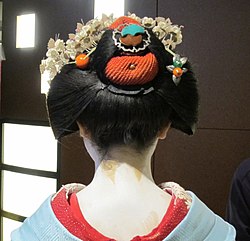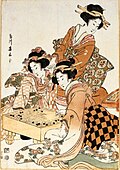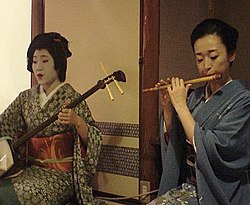Geisha
Geisha (芸者) (or geigi (芸妓) or geiko (芸子)) are traditional female Japanese entertainers. They are skilled at different Japanese arts, like playing classical Japanese music, dancing and poetry.
| Geisha | |||||
|---|---|---|---|---|---|

| |||||
| Two apprentice geisha (maiko) | |||||
| Japanese name | |||||
| Kanji | 芸者 | ||||
| |||||
The term 'geisha' is made of two Japanese words, 芸 ('gei') meaning 'art' and 者 ('sha') meaning 'person who does' or 'to be employed in'. The most literal translation of geisha to English is 'artist'. Geisha are respected as artists and performers: it is difficult to become one.[1]
Kyoto is the city with the most strict geisha traditions. Geisha have worked there for the longest time. Becoming a professional geisha can take up to five years of training in Kyoto.
Apprentice geisha are called maiko (舞子). This name is made of the Japanese words 舞 ('mai') meaning 'dancing' and 子 ('ko') meaning 'child'. Maiko wear white make-up called oshiroi and long-sleeved kimono of many bright colours. Maiko in some places wear a belt, called an obi, that is up to 6 metres (20 ft) long. Many maiko wear fancy hairstyles made with their own hair, though maiko in some places wear wigs. Full geisha wear simpler kimono, and only use white make-up at special times. Geisha also wear wigs, and their kimono belt is much shorter.
There are also geisha in other cities, though there are differences. In Tokyo, becoming a full geisha takes from six months to a year. Geisha apprentices in Tokyo are called han'gyoku (半玉), which means 'half jewel' or 'half pay'. Apprentice geisha in Tokyo are also called o-shaku (御酌), which means 'one who serves (alcohol)'. Geisha in Tokyo are normally older than geisha in Kyoto.[2]
Many geisha still live in traditional geisha houses called okiya (置屋) in neighborhoods called hanamachi (花街) which means 'flower town'. Older geisha who are successful may have their own home. A geisha always needs to be registered to a geisha house in order to work.
The world that geisha are a part of is called karyūkai (花柳界), which means 'the flower and willow world'.[3] One very famous geisha, Mineko Iwasaki, said this is because "[a] geisha like a flower, beautiful in her own way, and like a willow tree, gracious, flexible, and strong".[4]
Geisha are considered to be cultural icons of Japan.
History
Before the geisha appeared there were some women who worked as artists and entertainers. In the Heian Period (794-1185), some women entertained people at the Imperial Court through singing and dancing, and these women were known as shirabyōshi (白拍子).
Tayū could turn men away and got to decide who they did and did not entertain. Tayū were raised from a young age to be very skilled in different types of art and entertainment, and many of them became celebrities. Many woodblock prints and paintings of famous tayū, and other oiran, exist.
Geisha only appeared much later, in the Tokugawa period. Originally, geisha were men, who travelled throughout the red-light districts, entertaining clients with music, dancing and poetry. These men were known as geisha, but were also called otoko geisha (男芸者, 'male geisha'), hōkan (幇間, 'jesters') and taikomochi (太鼓持ち, 'drummers') because they played the taiko, a Japanese drum.[5]
Male geisha were very low-class entertainers, but oiran were thought to be upper class. Every man who wished to be with an oiran had to follow difficult rituals and etiquette, as well as having enough money to pay for her time. Because of this, only the richest nobility got to be entertained by oiran.[5] Because of this, many tea houses (ochaya (お茶屋)) appeared outside Shimabara, offering entertainment that was not offered inside Shimabara. However other women, who were called 'odoriko' ('dancing girls'), acted as dancers and musicians. These women soon became very popular. They started calling themselves 'geisha', like the male artists who worked in Shimabara.
By about the year 1700, female geisha had become much more popular than male geisha. A few years later, almost all geisha were women.[6]
Soon, the geisha became so much more popular than the oiran, that in 1761, the last tayū of Yoshiwara retired.[7] Though tayū continued to work in Kyoto and Osaka, oiran as a whole were seen as outdated, too traditional and too expensive. Oiran could not leave the red-light districts because they had a lot of debt to the owner of the brothel they worked in,[8] and were not thought of as celebrities or fashionable any more. Most people could not afford to hire them.[9][9] In contrast, geisha were cheaper, more fashionable, and could leave the red-light districts whenever they wanted. They sang popular songs and did not need several expensive meetings before they would entertain a client. New geisha neighborhoods (hanamachi) were created in Kyoto and other cities.
In the 19th century, geisha were in better position than common women, but they also had problems in Japanese society. Sometimes, poor people sold their daughters to a geisha house, though this was not as common as some people think, with many geisha coming from families where their mother or another female relative had once been a geisha. Geisha could not marry, but they could have a patron to pay for their expenses, and some retired when they gained a rich patron.
However, the reputation and respect for the geisha grew in the Meiji Restoration, and even more after World War II. Important laws that protected them were created. Young girls could not be sold to the geisha houses anymore. Since then, women only become geisha by their free will.[10]
Modern geisha
Numbers of geisha
Though people often talk about how there are not many geisha left in Japan, and that geisha might be about to die out, the geisha profession is very resilient. In history, sometimes the numbers of geisha fell, because of changes in the economy or because of war. However, the number of working geisha usually rose again not long after.
In the 1920s there were over 80,000 geisha in Japan. In 1944, all geisha districts were shut because of World War Two, and geisha, like everyone else, had to help out with the war; in Tokyo alone, close to 9,000 geisha were still entertaining guests before they were told they could not work as geisha anymore.[8]: Script error: The function "hyphen2dash" does not exist.  After the war, geisha districts opened up again on 25 October 1945. By 1967, there were nearly 5,000 geisha in Tokyo again.[8]: Script error: The function "hyphen2dash" does not exist. 
Today, there are far fewer geisha. The exact number of geisha working today is not known, but it is estimated to be around 1,000 to 2,000.[5]
Geisha in the 21st century
Geisha today live and work throughout Japan, in different geisha districts (hanamachi) that have their own traditions of arts, training and clothing. The most well known geisha live in Kyoto, where there are five geisha districts, and the most famous geisha district in Kyoto is Gion Kobu, which is sometimes just called Gion. There are also lots of geisha in Tokyo, and in towns with hot springs in them, like the town of Atami. In some places in Japan, people have decided to bring back the geisha districts that had no geisha in them for decades.
Many geisha houses and districts now use social media to advertise their work, and geisha do not need to be born into a geisha district to work there. Some geisha districts put on events to attract tourists; in Kyoto, places like Gion Corner put on dances performed by maiko that anyone can go and watch.
People can also pay to dress up like geisha or maiko for the day. Being dressed up as a geisha or maiko is known as henshin. Some dress-up services, like those in Kyoto, allow you to walk around the city for the day in dress-up. However, they will not dress someone completely accurately, so that real geisha and maiko cannot be confused with people in costumes. If someone wearing henshin wants to be dressed the exact same as a geisha or maiko, they cannot walk around outside. Most, if not all, henshin services will take photographs of someone in dress-up for them to keep. Real geisha do not have the time to take pictures with tourists, so most women dressed as geisha or maiko who appear on the photos of tourists are in fact people in henshin.
Young women who wish to become geisha now usually begin their training after finishing junior high school, or even high school or college. Many women begin their careers as adults. Geisha still study traditional musical instruments like the shamisen, the shakuhachi (bamboo flute), and drums, as well as traditional songs, Japanese traditional dance, tea ceremony, literature and poetry. By watching other geisha, apprentices also become skilled in the difficult traditions of dressing, make-up, and in dealing with clients.
Geisha are often hired to go to parties and gatherings, at tea houses or at traditional Japanese restaurants (ryōtei). Their time is measured by the time it takes an incense stick to burn, and is called senkōdai (線香代) ('incense stick fee') or gyokudai (玉代) ('jewel fee'). In Kyoto the terms ohana (お花) and hanadai (花代), meaning 'flower fees', are used instead. The clients hire the service of geisha through the geisha district's union or registery office, known as the kenban (検番), which takes care of the geisha's schedule, and will make appointments for her to entertain customers and train in the traditional arts.[11]
Training
Traditionally, geisha began their training at a very young age. Although some girls were sold to become geisha as children, this was not normal practice in hanamachi with good reputation.[12] Daughters of geisha were often educated as geisha themselves.
The first part of training is called "shikomi". In the past, when girls first arrived at the okiya, they were put to work as maids, or do everything they were told. The work was difficult, to "make" and "break" the new girls. The most junior shikomi of the house had to wait late into the night for the senior geisha to return from work, sometimes as late as two or three in the morning. During this stage of training, the shikomi went to classes at the hanamachi's geisha school. In modern times, this stage still exists, but it is not as hard as it was in the past. Now, shikomi become used to the traditions and dress of the "karyūkai" ("flower and willow world").
When the apprentice became skilled in the geisha arts, and passed a final and difficult dance test, she was promoted to the second stage of training: "minarai". Minarai did not do the housework anymore. This stage also exists today, but is much shorter than in the past (only a month). The minarai learn in the field. They go to banquets and dance with the geisha, but they do not participate: they just sit, watch and learn from their onee-san (older sisters). Their kimono are more elaborate than even a maiko's, to do the talking for them.
After a short time, the third (and most famous) stage of training begins, called "maiko". Maiko are apprentice geisha, and this stage can last for years. Maiko learn from their senior geisha and follow them around to every presentation she does. The "onee-san/imoto-san" ("older sister/younger sister") relationship is very important. The onee-san teaches her maiko everything about working in the hanamachi. She will teach her the right ways of serving tea, playing the shamisen, and dancing, and everything about the art of Iki (see below). Maiko have to wear heavy white make-up, elaborate hairstyle, and have her lips painted almost all the time. Their kimono and obi have more vibrant colors and richer embroidery than those of full geisha. Like the minarai, maiko do not charge as much money to go to parties or gatherings as a full geisha.
After a period of only six months (in Tokyo) or five years (in Kyoto), the maiko is promoted to a full geisha and charges full price for her time. Geisha use kimono of fewer colors and only use make-up for work or dance, because she is more mature than a maiko, and the simpler style shows her own natural beauty. Geisha remain as such until they retire.[11]
The art of geisha and Iki
Geisha must be very skilled at traditional Japanese music, dance, and poetry, because they use all these arts when they work. The art of make-up, hairstyles, and clothing are very important too.
The most important principle of a geisha is called iki.[13] Iki started in the 18th century as a reply to the extravagant ways of the courtesans (oiran) and those who liked their style. Oiran wore very elaborate clothes, make-up, and jewelry. Geisha preferred to be discreet, and more intelligent. They created iki as a style that gave more importance to conversation and wit. A geisha will flirt, tease, and joke with men, but always with art and elegance.
Becoming a geisha needs much discipline. A geisha believes she must be a work of art in herself. They work every day to improve, in everything they do. A geisha's movements, her way of walking, sitting and talking are very important. Geisha are geisha all the time, even when they are at home or not working. An example of this dedication is the old custom of kangeiko ("lessons in the cold"). Until the early 1920s, apprentice geisha used to put their hands in icy water, and then go outside in cold weather to practice playing the shamisen until their fingers bled.[14][15]
Picture gallery
- Maiko
- Geisha
Two geisha playing the shamisen and the shinobue.
Related pages
References
- ↑ Ito, Masami (2017-11-25). "Japan's geisha battle to protect their future". Japan Times. Retrieved 2020-10-15.
- ↑ "Tokyo Asakusa" (in 日本語). Taito-ku Association of Tokyo. Archived from the original on 13 September 2011. Retrieved 21 August 2007.
- ↑ ""Geisha, A Life", by Mineko Iwasaki". MostlyFiction.com. Retrieved 31 May 2019.
- ↑ Iwasaki, Mineko (2003). Geisha: A Life. Washington Square Press. p. 7. ISBN 0-7434-4429-9.
- ↑ 5.0 5.1 5.2 "Inside Japan". Hanami Web. Archived from the original on 24 February 2015. Retrieved 21 August 2007.
- ↑ Dorda, Cristina. "Geigi Gakko" (in español). Archived from the original on 11 August 2014. Retrieved 21 August 2007.
- ↑ "About Japanese Courtesans' Names". issendai.com. Issendai. Archived from the original on 12 July 2020. Retrieved 14 July 2020.
- ↑ 8.0 8.1 8.2 Cite error: Invalid
<ref>tag; no text was provided for refs namedDalby Geisha. - ↑ 9.0 9.1 Kimino, Rinko; Ichikawa, Somegoro (2016). Photographic Kabuki Kaleidoscope (1st ed.). Tokyo: Shogakukan. p. 18. ISBN 978-4-09-310843-0.
- ↑ Cite error: Invalid
<ref>tag; no text was provided for refs namedbooker. - ↑ 11.0 11.1 "El mundo de la flor y el sauce" (in español). Japonismo.com. Retrieved 31 May 2019.
- ↑ Varley, p. 142.
- ↑ Varley, pp. 144-145.
- ↑ Cite error: Invalid
<ref>tag; no text was provided for refs namedshizuka. - ↑ Varley, p. 151
Other websites
| Wikimedia Commons has media related to Lua error in Module:Commons_link at line 62: attempt to index field 'wikibase' (a nil value).. |
- Geiko and Maiko Photo Gallery Archived 2012-04-15 at the Wayback Machine, by Lubomir Cernota.
- Geisha and Maiko, Haruyo Morita's art.
- Coming of Age - Yukina: Japan. Documentary about a modern young woman who wishes to train to be a geisha. BBC.com
















